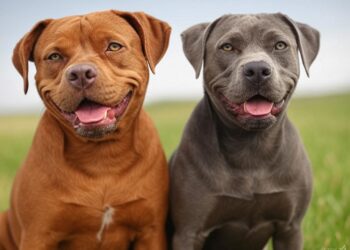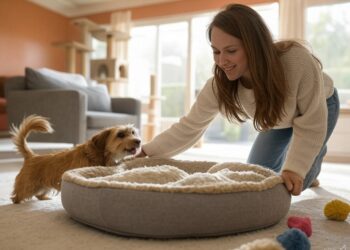Puppies are cute and adorable. They give you lots of unconditional love and snuggles and are all around a wonderful addition to your family. There’s one not-so-great thing about puppies, though, and that is their constant need to get into your belongings as they discover the world.
While exploring your home is to be expected, puppies can sometimes take it too far. When your puppy or dog begins chewing on your belongings, it is a good idea to learn about why they do this and identify ways to stop bad behavior before it gets out of hand. Keeping your puppy busy with cute dog toys is an excellent way to prevent your belongings from being damaged and to keep your pet happy.
Why Do Puppies Chew on Things?
It is helpful to understand why your puppy is getting into your things, and more importantly, why this exploration almost always ends in your dog chewing on items they shouldn’t. Puppies and dogs chew on their owner’s possessions for many reasons, depending on their age and mental state. The following are common reasons that dogs chew on their owners’ stuff.
Dental health
Dogs have an innate need to chew on things because it helps keep their teeth clean and jaws strong. Puppies chew because it is a way of relieving pain caused by incoming teeth. Older dogs chew because it exercises their jawbones and rubs their teeth to remove plaque and dirt.
Mental health
Dogs may chew to relieve anxiety, confusion and frustration. It is a way for them to work out these feelings and remove the stress caused by anxiousness or even overstimulation. A dog’s chewing is comparable to a human yoga class or meditation routine. It helps them with their mental health and stress levels.
Relieve hunger or boredom
If your dog is on a restricted diet, it might begin to suck or chew on items in your house. Dogs who are bored and lack stimulation or exercise may also turn to chewing or pawing at your furniture or other things to keep themselves entertained.
Separation anxiety
Separation anxiety is a real problem for animals, and if your dog suffers from the condition, their destructive behavior will increase unless you deal with the situation. Separation anxiety is different from mild or general anxiety in dogs and is specifically tied to their anxiety in your absence. In the case of severe separation anxiety, your puppy might claw their way through doors, floors or furniture in their attempt to calm these nerves.
Common Items Puppies and Dogs Target
There are everyday items around your home that pique a puppy’s curiosity. If you leave these items lying around, don’t be surprised to see your puppy chew or suck on them. They simply can’t help themselves.
Furniture or blankets
Dogs who are weaned early often do “fabric sucking.” Some dogs do this well beyond the expected time frame. When this happens, the behavior is most likely compulsive, and resolving it may require professional input from your vet.
Socks and shoes
Ever wonder why do dogs like socks? Most dogs find socks and shoes to be the perfect items to chew on. It keeps their anxiety down, and, as gross as it sounds, they probably like the way your dirty socks smell like you.
Cardboard, paper, tissues
Dogs chew on cardboard boxes because they can rip them and hold the pieces with their mouth. Chewing and ripping keep their anxiety and boredom down. Paper items like book jackets, loose notebook paper and tissues provide entertainment for your dog.
Food and trash
Dogs love to eat, and they don’t care if the food is from the trash can. If your trash can doesn’t have a lid, expect a growing and curious puppy to knock it over and dig around for a treat.
Plants
Dogs like to dig outside in the dirt, but sometimes they find big potted plants indoors to dig in instead. Puppies are known to knock over plants and play in the soil if they get bored.
How to Prevent Damage to Your Belongings
When your puppy gets into your things, it doesn’t just ruin your household items; it can also hurt your furry friend. It is essential to train your puppy so that it doesn’t turn to your belongings for comfort. Follow these steps to prevent damage to your things and make sure your dog is occupied throughout the day.
Remember that chewing is normal
Dogs chew. Don’t get angry at your dog for their normal behavior. It is your responsibility to train your puppy and let them know what they can and can’t chew on.
Provide your dog with toys
Provide your dog with lots of varied toys to keep them entertained. Ropes, plushies, thick rubber balls and puzzle toys are good ideas. Puzzle toys hide a snack in the middle and engage your dog’s problem-solving skills, while a squeaky toy keeps their ears entertained.
Provide your dog with edible items
Along with non-edible toys, give your dog edible items like pig ears or rawhide bones. Keep a close eye on your pet because if they try to eat these items too quickly, they may choke on a big piece. Also, allow your dog to take its time with an edible item and not fight over it with another pet.
Keep your dog busy
One of the best ways to prevent destructive chewing is to keep your dog busy. Take your pet on lots of walks, play fetch with your dog and talk to and pet them often. The less anxious your dog feels, the fewer destructive patterns he will develop.
Dog-proof your house
Just like you would babyproof a house, make sure you dog-proof your home when you get a new puppy. Put common chewing temptations away and give your puppy the appropriate toys to play with so they learn what’s acceptable to play with and what’s not.
Keep an eye out for patterns
Watch your dog’s chewing habits. Notice if any behavior gets worse or more intense. Also, look for patterns when your dog gets into your things or if there are specific items that your pet goes after. Keeping track of these patterns helps you address the problems specifically.
Always stay calm with your dog
The most important thing to remember is to stay calm when dealing with your dog. Avoid being aggressive or punishing your dog. If your dog is chewing on something it shouldn’t, take the item away and replace it with an article she can chew.
Train Your Puppy Early
Puppies and dogs get into your belongings for several reasons. Sometimes they are teething, exploring or tempted by certain scents; other times, this destructive behavior is due to separation anxiety in your pup. It is crucial to monitor your dog’s behavior and redirect it with appropriate distraction techniques. Be consistent in your training so you can relax with your well-trained dog later on.








